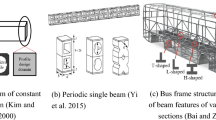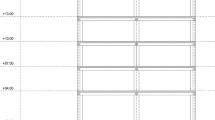Abstract
Multi-level skybridges and atria between tall buildings make possible a new urban paradigm that has the potential to dramatically reduce resource consumption, air pollution, and traffic accidents. Structural analysis and optimization methods and results are presented for tall buildings connected with roller or hinge-skybridges at multiple levels and atria between buildings. Generic building systems were studied with controlled factors such as number of buildings, equal-height vs. variable-height, skybridge connection type, site seismicity and wind intensity, and presence/absence of skybridges and atria. The 48 optimization problems held all other factors constant such as building width, shape, configuration, and spacing. A simplified lateral load analysis model is described which makes optimization of large systems possible. The simplified lateral load analysis model was compared to a finite element model for accuracy. An optimization strategy was developed involving gradient and evolutionary algorithms. Results show that atria and hinge-connected skybridges reduced the total structural volume by as much as 10 %.















Similar content being viewed by others
References
Arch Daily (2009) Linked hybrid/Steven holl architects http://www.archdaily.com/34302/linked-hybrid-steven-holl-architects/
Architecture Lab (2010) Pinnacle@Duxton, Singapore by ARC studio architecture + Urbanism. http://architecturelab.net/pinnacle-duxton-singapore-by-arc-studio-architecture-urbanism/
ASCE (2010) ASCE 7–10, minimum design loads for buildings and other structures. American Society of Civil Engineering, Reston
Balling RJ (1991) Computer structural analysis. BYU Academic Publishing, Provo
Balling RJ, Bessey RP (2015) Flexible lightweight cable-spring support system for ETFE cushions spanning between buildings. ASCE J Struct Eng 141(5):04014142
Balling RJ, Lee JS (2015) Simplified model for analysis and optimization of skyscrapers with outriggers and belt trusses. ASCE J Struct Eng 141(9):04014231
Bharti SD (2010) Seismic response analysis of adjacent buildings connected with MR dampers. Eng Struct 32(8):2122–2133
Bobby S, Spence S, Bernardini E, Kareem A (2015) Performance-based topology optimization for buildings under wind and seismic hazards. Struct Congress 2015:2218–2229
Boggs DW, Hosoya N (2001) Wind-Tunnel Techniques to Address Structures with Multiple Coupled Interactions. Proceedings of the 2001 Structures Congress & Exposition. Washington D.C.
Chan C-M, Wong K-M (2008) Structural topology and element sizing design optimisation of tall steel frameworks using a hybrid OC–GA method. Struct Multidiscip Optim 35(5):473–488
CTBUH (2015) Height & statistics. The skyscraper center. http://www.ctbuh.org/TallBuildings/HeightStatistics/HeightCalculator/tabid/1007/language/en-US/Default.aspx, (April 29, 2015)
IBC (2006) International building code, Country Club Hills, IL
Kundu S, Seto K, Sugino S (2002) Genetic algorithm application to vibration control of tall flexible structures. Proc., Electronic Design, Test and Applications, 2002. Proceedings. The First IEEE International Workshop, 333–337
Liang B, Liu J (2009) A new approach to determine the optimum structure system for tall buildings using artificial neural networks and PSO algorithms. Proc., natural computation, 2009. ICNC '09. fifth international conference, 181–185
Lim J (2007) Wind-induced response of structurally coupled twin tall buildings. Wind and Structures, An International Journal 10(4):383–398
Liu DK, Yang YL, Li QS (2003) Optimum positioning of actuators in tall buildings using genetic algorithm. Comput Struct 81(32):2823–2827
Luco JE (1998) Control of the seismic response of a composite tall building modelled by two interconnected shear beams. Earthq Eng Struct Dyn 27(3):205–223
Mu Z (2011) Analysis of stress response for the super high rise double-tower connected structure with the trusses of changing rigidity. Adv Mater Res 291-294:1559–1563
Nishimura A (2011) Base-isolated super high-rise RC building composed of three connected towers with vibration control systems. Struct Concr 12(2):94–108
Parkinson AR, Balling RJ (2002) The OptdesX design optimization software. Struct Multidiscip Optim 23(2):127–139
Parkview Green (2015) http://www.parkviewgreen.com/eng/about/parkview-group/parkview-group/
Patel CC (2010) Seismic response of dynamically similar adjacent structures connected with viscous dampers. IES J Part A: Civ Struct Eng 3(1):1–13
Roaf S, Crichton D, Nicol F (2005) Adapting buildings and cities for climate change: a 21st century survival guide. Architectural Press, Oxford
Spence SMJ, Gioffrè M (2011) Efficient algorithms for the reliability optimization of tall buildings. J Wind Eng Ind Aerodyn 99(6–7):691–699
WikiArquitectura (2010) Umeda sky building. Buildings of the world, http://en.wikiarquitectura.com/index.php/Umeda_sky_building. (May 1, 2013, 2013)
Wikipedia (2010) Island tower sky club. Wikimedia commons, www.wikipedia.org
Xie J, Irwin PA (1998) Application of the force balance technique to a building complex. J Wind Eng Ind Aerodyn 77–78:579–590
Yuan W (2011) Influence of connection location on dynamic characteristics of three-towers-connected high-rise building. Adv Mater Res 243-249:419–425
Zhou Y (2011) Study on the seismic performance of a multi-tower connected structure. Structural Design of Tall and Special Buildings, 20(3):387-401
Acknowledgments
The authors gratefully acknowledge the financial support for this work from the King and Diane Husein Professorship at Brigham Young University.
Author information
Authors and Affiliations
Corresponding author
Rights and permissions
About this article
Cite this article
McCall, A.J., Balling, R.J. Structural analysis and optimization of tall buildings connected with skybridges and atria. Struct Multidisc Optim 55, 583–600 (2017). https://doi.org/10.1007/s00158-016-1518-y
Received:
Revised:
Accepted:
Published:
Issue Date:
DOI: https://doi.org/10.1007/s00158-016-1518-y




